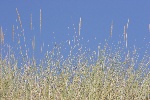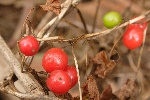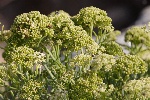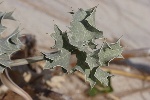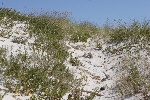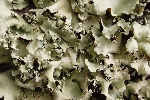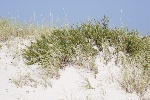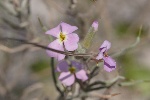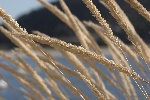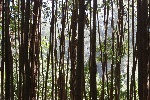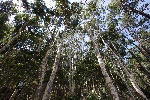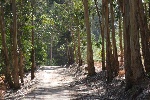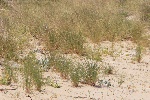Cies Islands
Flora
Due to the harsh environmental conditions on the Cíes islands (wind, sun, lack of water and nutrients, salinity etc.) only few species of plants and trees survive. However, the species that are found are of great value as they are exclusive to this ecosystem and are able to adapt to this hostile environment.
Some of the species found on the islands are no longer present in the rest of Galicia.
Some of the ways the plants have had to adapt are the following:
- Deeper roots to reach underground water sources
- Hair-like structures on the leaves to avoid drying out
- Fleshy tissue to store water
- Light colours to reflect sunlight
- Bulbs and rhizomes on the roots to store food
- Thickening of the tissue as a defence mechanism
- Rolling of the leaves to avoid evaporatio
Some species:
-
Angelica (angelica archangelica): thick-stemmed leafy plant with greenish-white flowers. Maximum height between 1.40 and 2.30m. On Cíes it is found on the cliffs but it is rarely found in Spain. It is an aromatic herb and is used medicinally.
-
Thrift (armeria pungens): shrub that grows up to 50cm found in the southwest of the Iberian Peninsula, Cíes Islands, south Portugal, Corsica and Sardinia. In the past the climate on the Galician coast was warmer and this species advanced from the south. However, it later receded due to climate change.
-
European beach grass (ammophila arenaria): perennial plant with stems measuring 60-120cm in height and with rhizomes. As its roots reach more than 4 metres deep, it is one of the most important plant species on the dunes.
-
Portuguese Crowberry (corema album): leafy shrub that grows up to 1m high. This species is unique to the west coast of the Iberian Peninsula and the Azores. The dunes on Cíes have the largest and most important growth in Galicia. It is categorized as an endangered species.
-
Beach pea or Sea pea (eryngium maritimum): perennial plant that grows to 60cm. It has an unusual metallic blue colour. It is typical of coastal Europe.
-
Riviera Bindweed (convulvus althaeoides): perennial plant that grows in sandy soils. It may reach a height of 2.5m. The flowers are a striking wine-pink colour. The stems wind around those of other plants. It is usually found on the side of paths.
-
Rockrose (cistus salvifolius): leafy perennial shrub that grows up to 1m high. It is an aromatic plant common in Mediterranean countries. It survives well in harsh droughts and in poor soils. It has astringent and healing properties.
-
Wild candytuft (iberis procumbens): evergreen perennial plant that grows up to 20-30cm in height, with a suffruticous stem. They are very resistant to heat and drought and bear the cold quite well. These plants are only found on the south and west coast of the Iberian Peninsula.
-
Spanish/Sweet Chestnut Tree (castanea sativa): deciduous tree with a thick trunk and hard wood. It may grow to a height of more than 30m. It grows in all types of soils but prefers cool deep conditions. In Galicia it is grown for its chestnuts (once the staple diet for humans and animals) and for its wood (used in construction for doors, beams, roofing etc).
-
Blackthorn (prunus spinosa l.): perennial bush of the rosaceae family. It usually does not grow beyond a bush but it may be found as a small tree of up to 6m. The flowers are white and its fruit - sloes - are a very dark blue. It is native to Europe and west Asia.
-
Asparagus (asparagus plumosus): green climbing plant with long thin stalks. It may reach a height of 5m. It originally comes from South Africa. It is used widely in flower arranging.
-
Eucalyptus (eucalyptus globulus): evergreen tree that grows up to 60m. It is sensitive to prolonged drought. It prefers slightly acid and cool soil conditions. Its origin is Australia. There are more than 300 species of eucalyptus. It has antiseptic, balsamic, stimulating and other properties.
-
Common / European Ash (fraxinus excelsior): deciduous tree which grows to a height of between 8 and 12m (but reaching 40m in some cases). It prefers cool areas (with relative humidity) and does not tolerate dry hot climates. The leaves have diuretic and laxative properties and are even anti-rheumatic when mixed with other plants.
-
Sea Fennel (crithmum maritimum): green coloured perennial plant with flexible stems, it measures between 15 and 45cm. it is found in cracks and holes in the cliffs and sometimes in sandy areas, but rarely. It is very rich in minerals and vitamin C. It was once used by the sailors to prevent scurvy on long journeys.
-
Vicar’s Mead (cistus monspeliensis): green evergreen leafy shrub with a medium-sized stem. The flowers are white with 5 petals, triangular in shape. It is not demanding as regards soil type and tolerates both frost and hot conditions well.
-
Sea Daffodil, Sea Lily, Sand Lily (pancratium maritimum): perennial plant that grows up to between 30 and 70cm in height with a bulbous root. It bears long periods of drought well. It is found on the Atlantic and Mediterranean Coasts. In the past it was used as a purgative.
-
Monterrey Pine (pinus radiata): evergreen tree that reaches a height of between 30 and 40m with a black bark. It favours mild climates with high humidity. This species was reforested on the islands in the 1950s. It is originally from California, the west coast of the USA. The wood is used especially for paper pulp manufacturing.
-
Maritime Pine or Cluster Pine (pinus pinaster): evergreen tree that reaches a height of 30-40m with a thick reddish brown coloured bark. The wood is not of high quality but it does produce large quantities of resin.
-
Osyris (Osyris alba): this shrub reaches a maximum height of 2m. It has greenish flowers and red pea-sized drupes. It inhabits wet areas and tolerates all soil types.
-
Galicio-Portuguese pedunculate oak wood and Quercion pyrenaicae (quercus pyrenaica): this is an autochthonous species. It is a deciduous tree that grows no higher than 20m. It bears acorns and tolerated frosts well. It can live between 500 and 600 years. It is scarce due to excessive cutting and competition from foreign species.
-
Wild Thyme (helichrysum picardii virescens): small shrub that grows up to 50cm. It grows in all types of soils and tolerates drought well. It is originally from the west coast of the Iberian Peninsula only. Galicia is the most northern area where it is found. It has many medicinal properties.
-
Gorse (Ulex europaeus): thorny shrub with many branches that reaches a height of 2m. It has yellow flowers. It adapts well to poor dry soils and favours a cool climate. It has medicinal properties as a diuretic, anti-migraine, etc.
Cargando
recomendaciones
Concello de Vigo
Praza do Rei - 36202 - Vigo (Pontevedra) - Teléfono: 010 - 986810100
Buscador Vigo25
×


